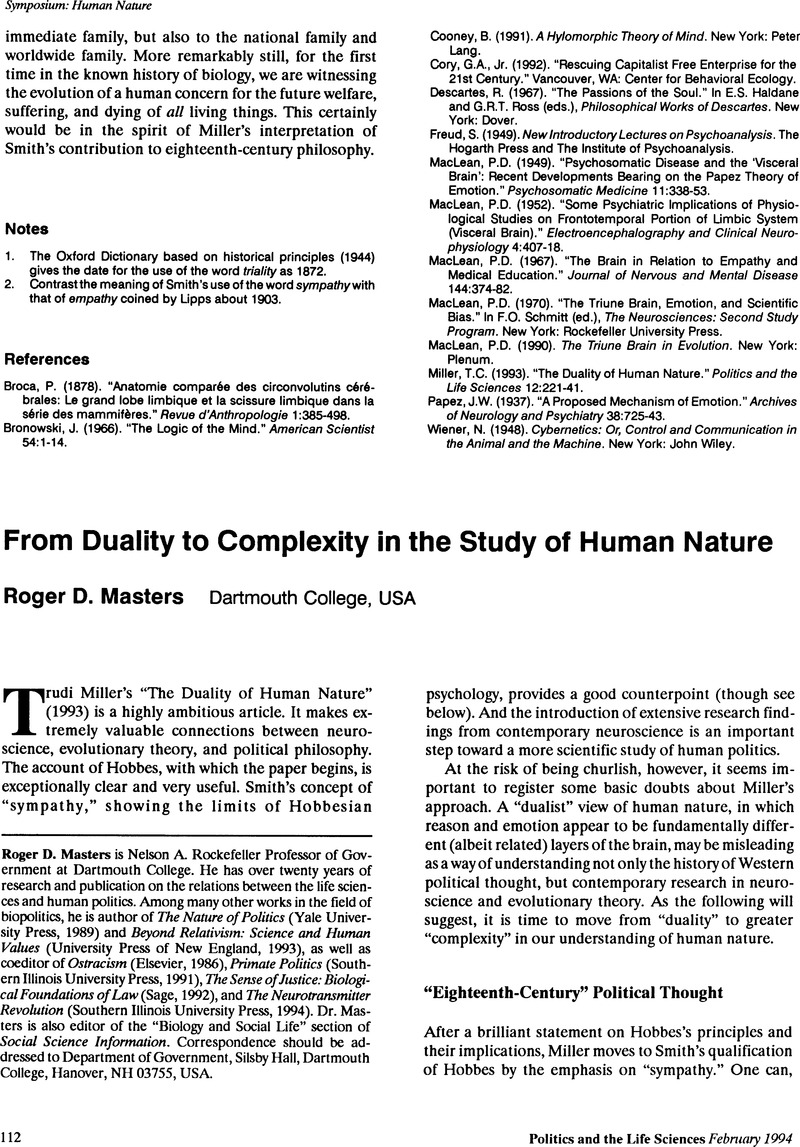No CrossRef data available.
Article contents
From Duality to Complexity in the Study of Human Nature
Published online by Cambridge University Press: 17 May 2016
Abstract
An abstract is not available for this content so a preview has been provided. Please use the Get access link above for information on how to access this content.

- Type
- Symposium: The Duality of Human Nature
- Information
- Copyright
- Copyright © Association for Politics and the Life Sciences
References
Arnhart, L. (1990). “Aristotle, Chimpanzees, and Other Political Animals.” Social Science Information 29:479–559.Google Scholar
Kling, A. (1986). “Neurological Correlates of Social Behavior.” In Gruter, M. and Masters, R. (eds.), Ostracism: A Social and Biological Phenomenon. New York: Elsevier.Google Scholar
MacLean, P. (1992). “A Triangular Brief on the Evolution of the Brain and Law.” In Gruter, M. and Bohannan, P. (eds.), Law, Biology, and Culture. 2nd edition. New York: Primis-McGraw Hill.Google Scholar
Marcus, G.E. and MacKuen, M.B. (1993). “Anxiety, Enthusiasm, and the Vote: The Emotional Underpinnings of Learning and Involvement during Presidential Campaigns.” American Political Science Review 87:672–85.Google Scholar
Margolis, H. (1982). Selfishness, Altruism, and Rationality. New York: Cambridge University Press.Google Scholar
Maryanski, A. and Turner, J. (1992). The Social Cage: Human Nature and the Evolution of Society. Stanford, CA: Stanford University Press.Google Scholar
Masters, R.D. (1993a). Beyond Relativism: Science and Human Values. Hanover, NH: University Press of New England.Google Scholar
Masters, R.D. (1993b). “On the Evolution of Political Communities: The Paradox of Eastern and Western Europe in the 1990's.” In McGuire, M.T. (ed.), Human Nature and the New Europe. Boulder, CO: Westview. In press.Google Scholar
Masters, R.D. and Gruter, M., eds. (1992). The Sense of Justice: Biological Foundations of Law. Newbury Park, CA: Sage.Google Scholar
Masters, R.D. and Sullivan, D.G. (1993). “Nonverbal Behavior and Leadership: Emotion and Cognition in Political Attitudes.” In Iyengar, S. and McGuire, W. (eds.), Explorations in Political Psychology. Durham, NC: Duke University Press.Google Scholar
Miller, T.C. (1993). “The Duality of Human Nature.” Politics and the Life Sciences 12:221–41.CrossRefGoogle Scholar
Mishkin, M. and Appenzeller, T. (1987). “The Anatomy of Memory.” Scientific American 256:80–89.Google Scholar
Olson, M. Jr. (1965). The Logic of Collective Action. Cambridge, MA: Harvard University Press.Google Scholar
Olson, M. Jr. (1993). “Dictatorship, Democracy, and Development.” American Political Science Review 87:567–76.Google Scholar
Rolls, E.T. (1989). “The Processing of Face Information in the Primate Temporal Lobe.” In Bruce, V. and Burton, M. (eds.), Processing Images of Faces. London: Ablex.Google Scholar
Skarda, C.A. and Freeman, W.J. (1990). “Chaos and the New Science of the Brain.” Concepts in Neuroscience 1:275–85.Google Scholar
Tranel, D., Damasio, A.R., and Damasio, H. (1988). “Intact Recognition of Facial Expression, Gender, and Age in Patients with Impaired Recognition of Face Identity.” Neurology 38:690–96.Google Scholar
Wilson, F.A.W., Scalaide, S.P.O., and Goldman-Rakic, P.S. (1993). “Dissociation of Object and Spatial Processing Domains in Primate Prefrontal Cortex.” Science 260:1955–58.Google Scholar
Young, M.P. and Yamane, S. (1992). “Sparse Population Coding of Faces in the Inferotemporal Cortex.” Science 256:1327–31.Google Scholar
Zola-Morgan, S.M. and Squire, L.R. (1990). “The Primate Hippocampal Formation: Evidence for a Time-limited Role in Memory Storage.” Science 250:288–90.Google Scholar




